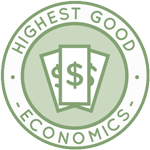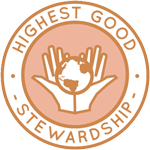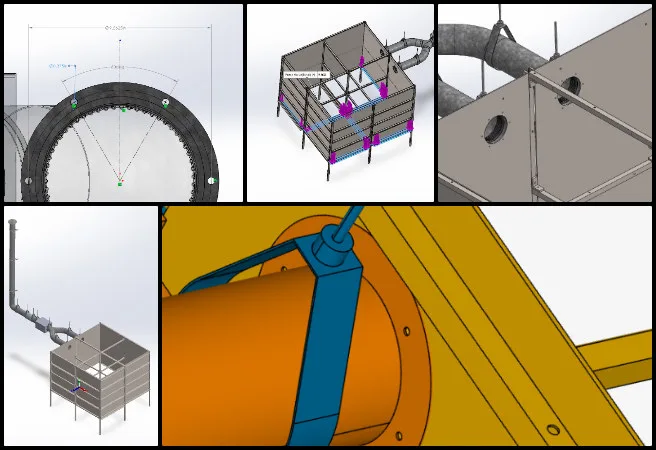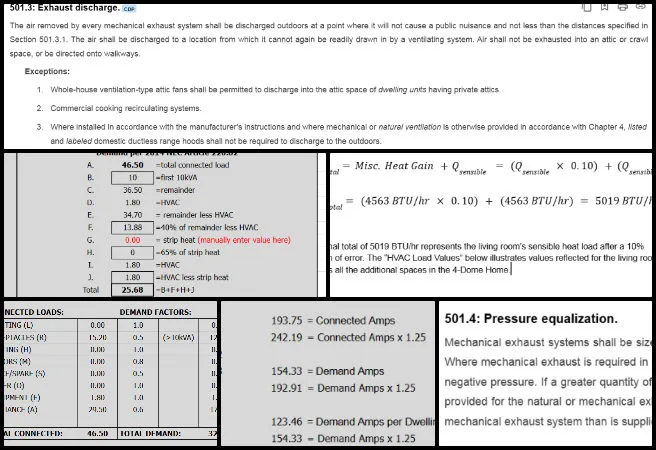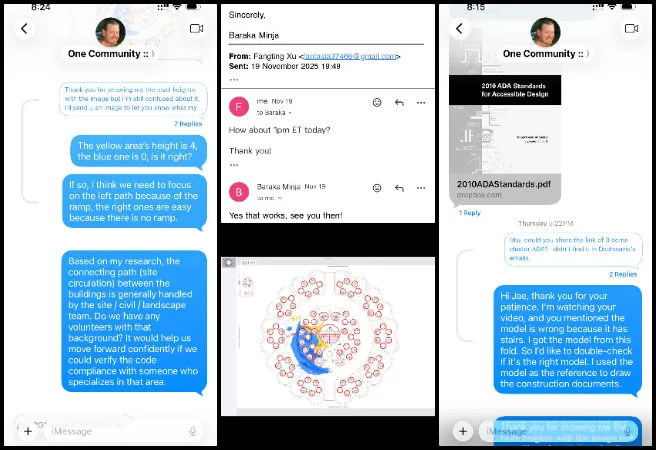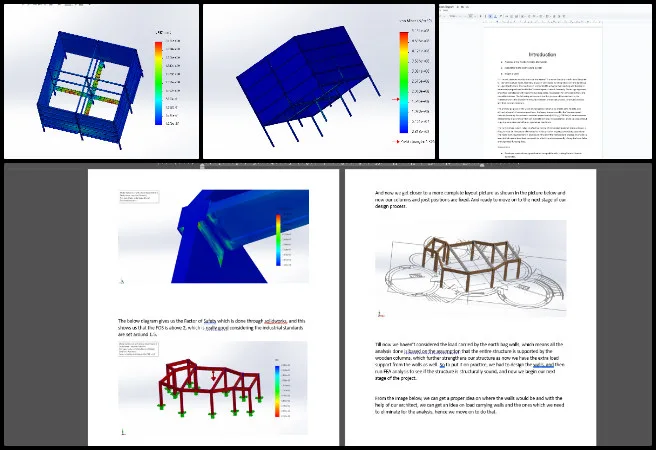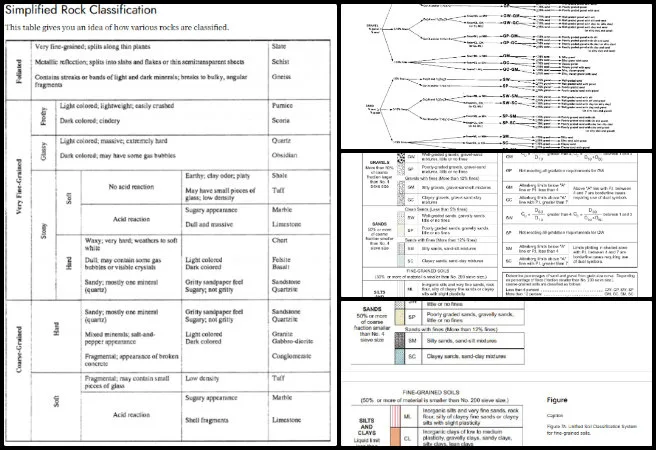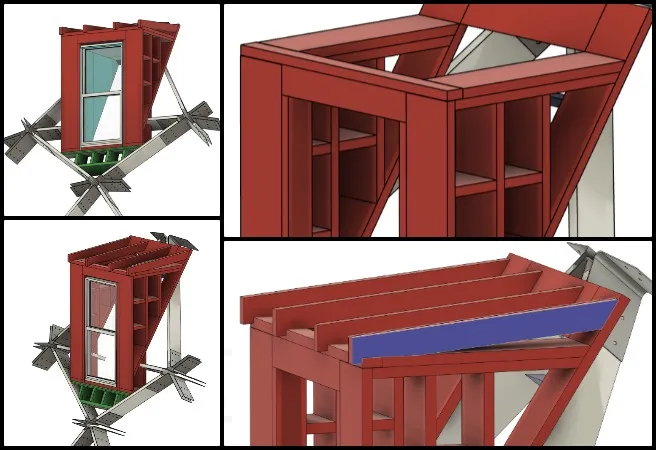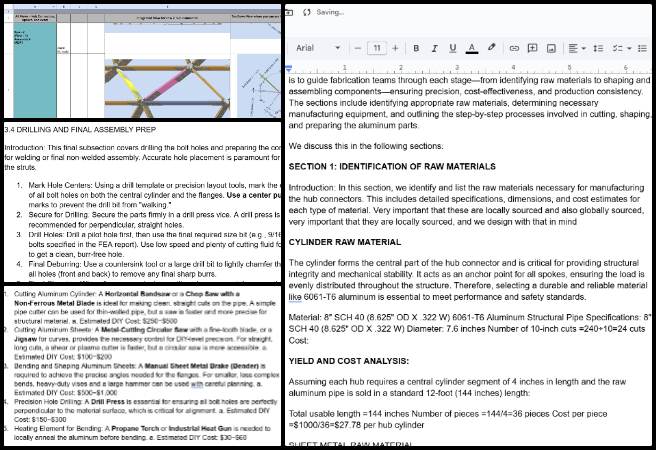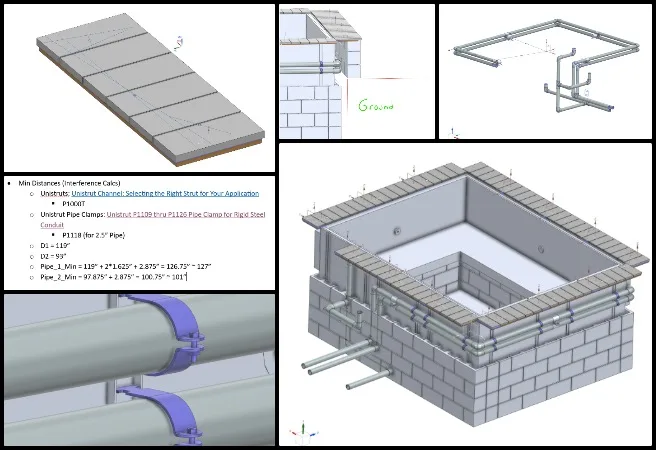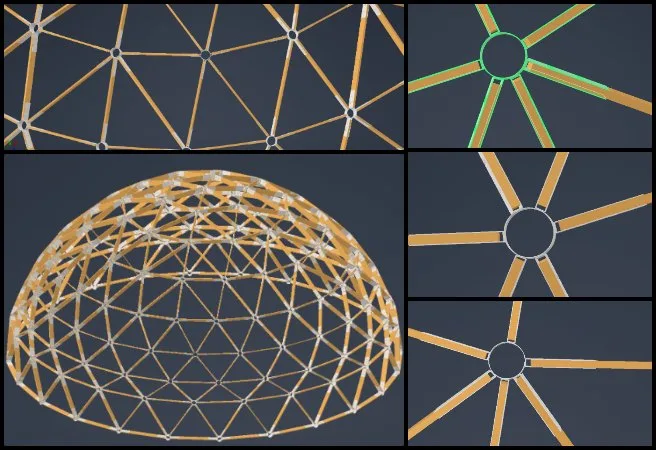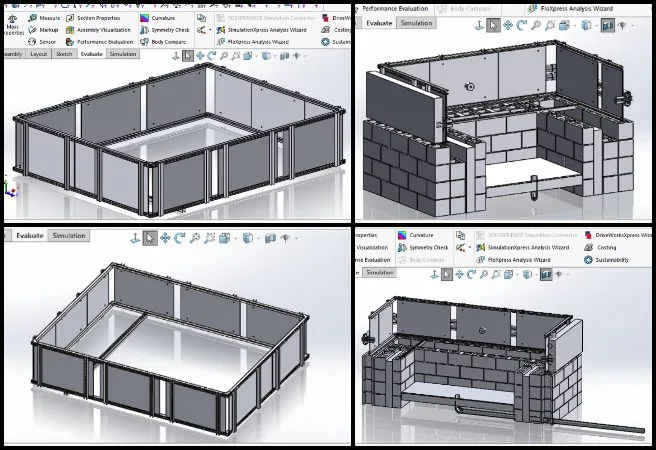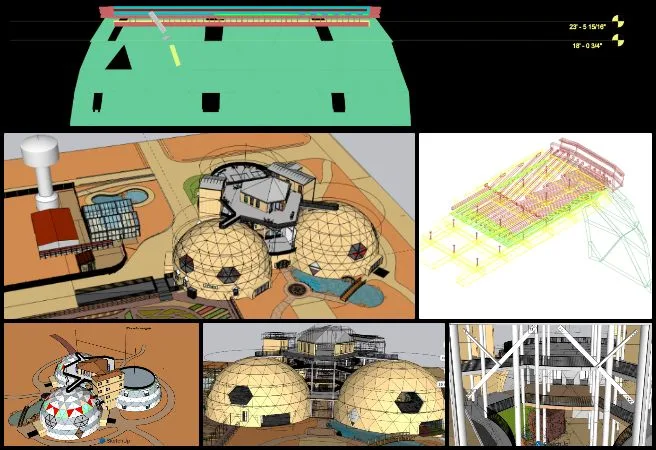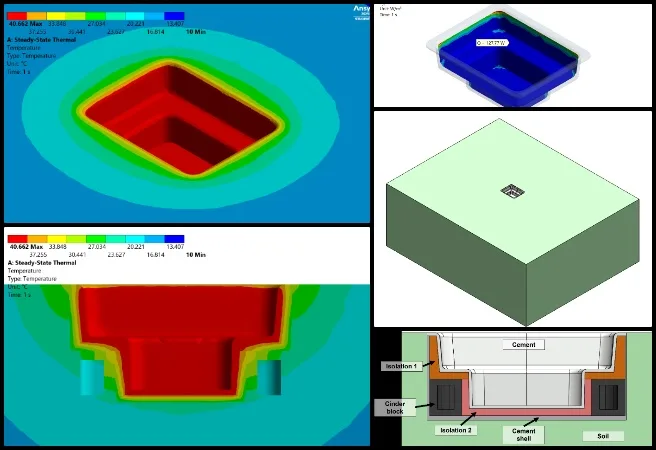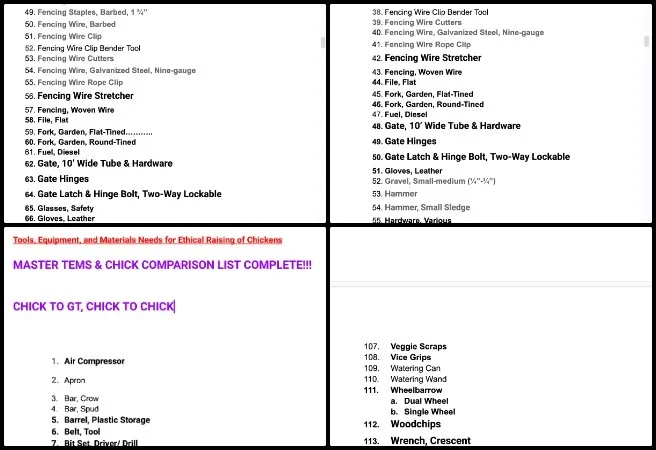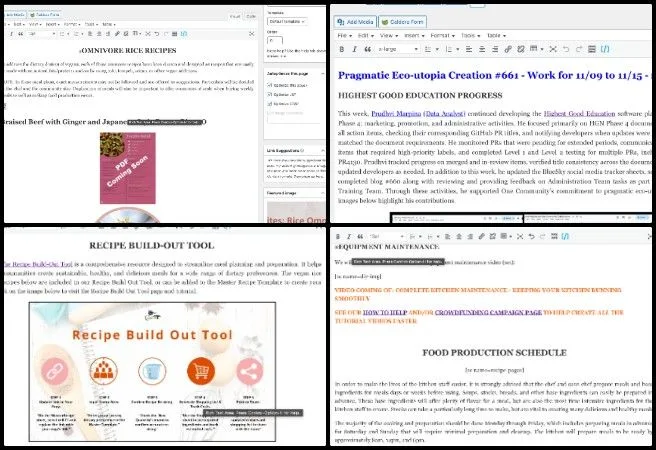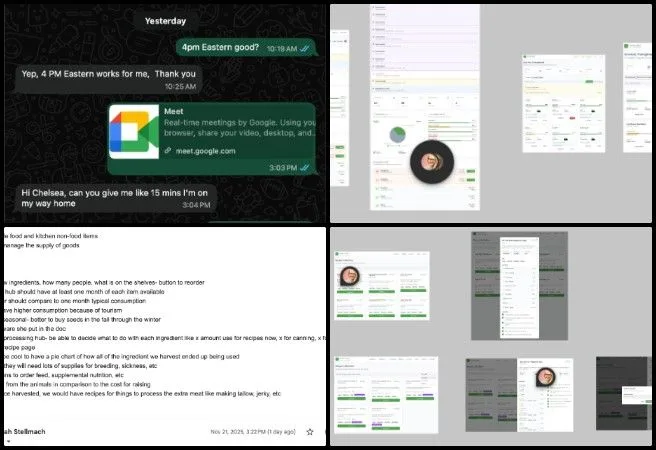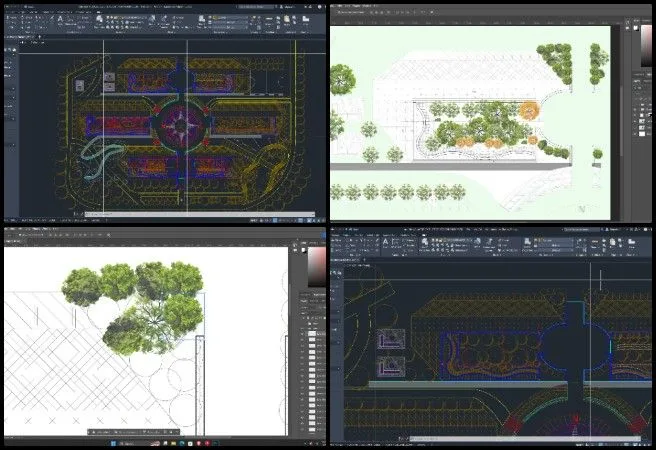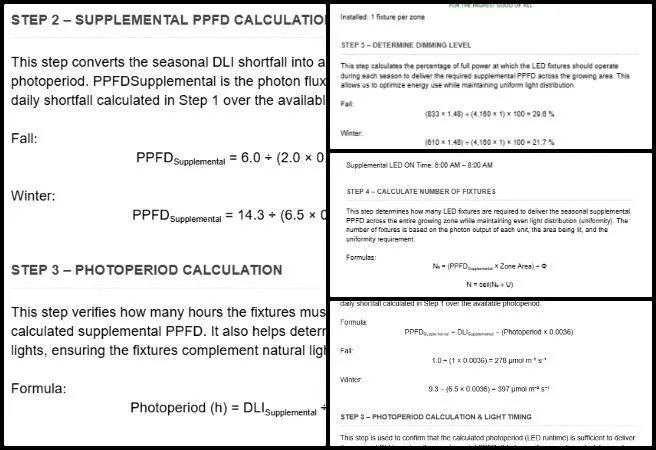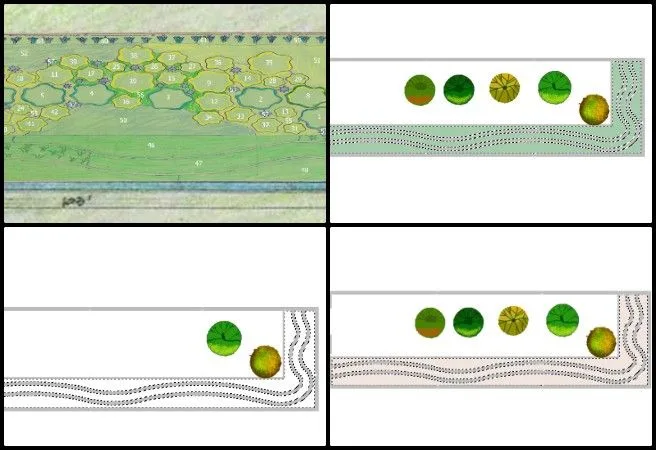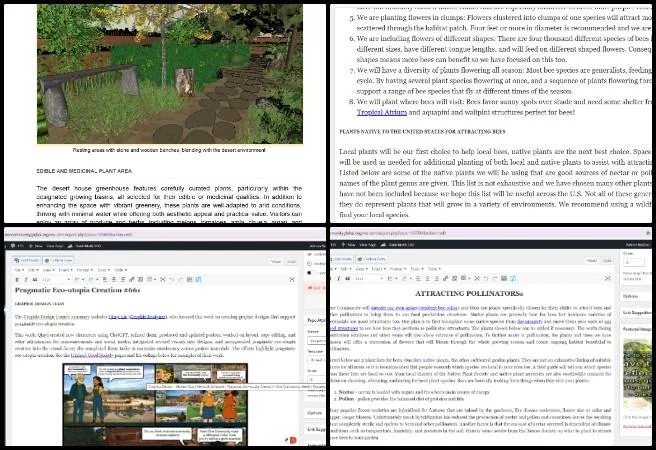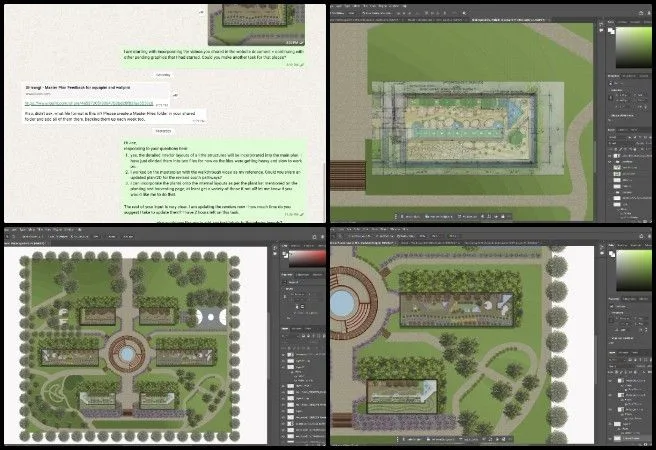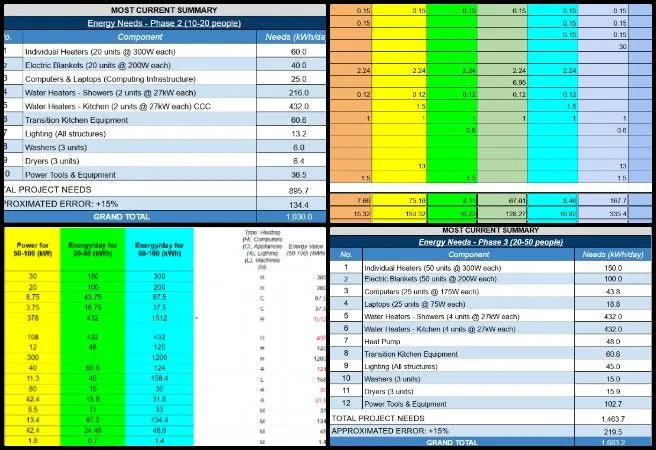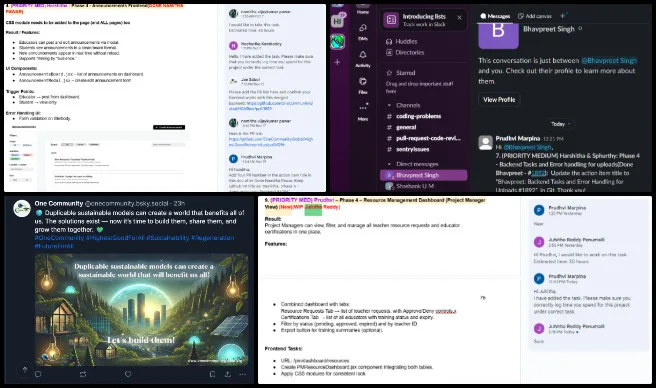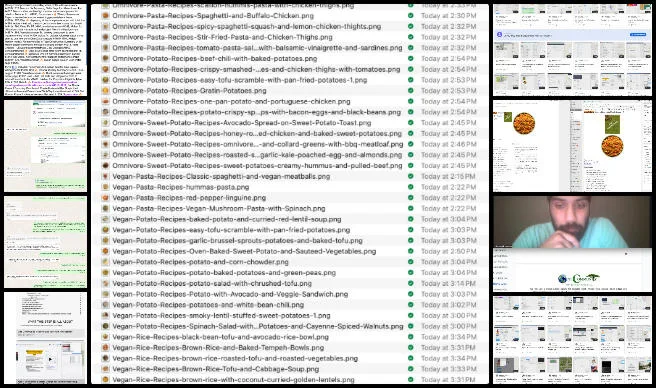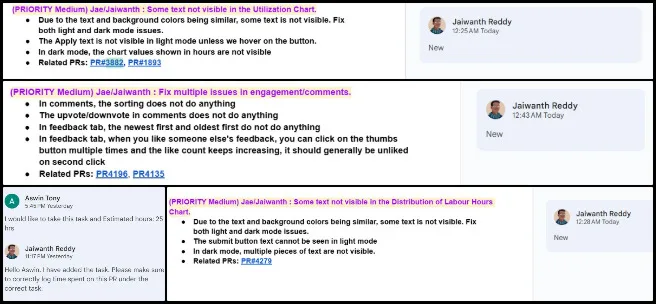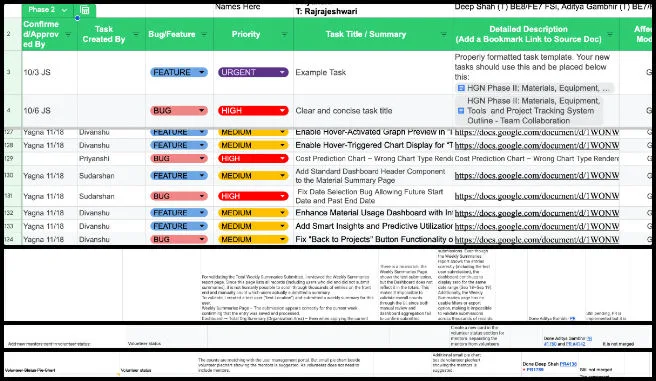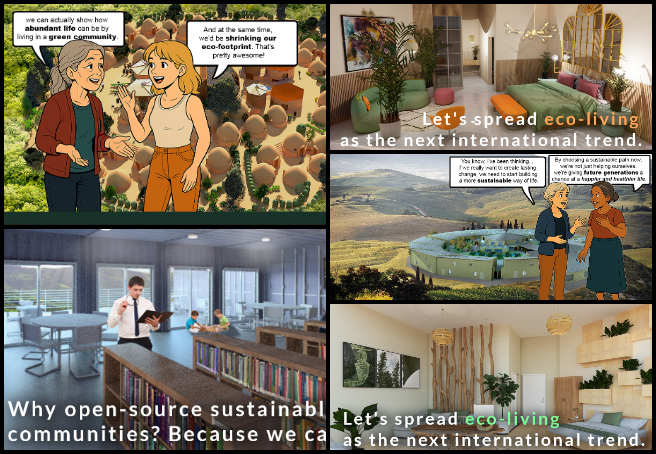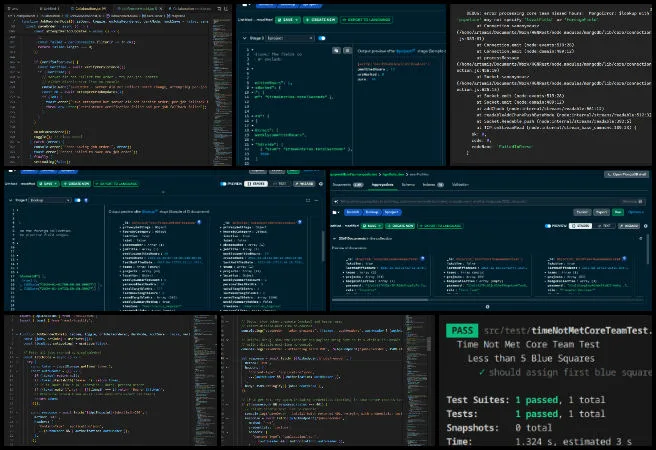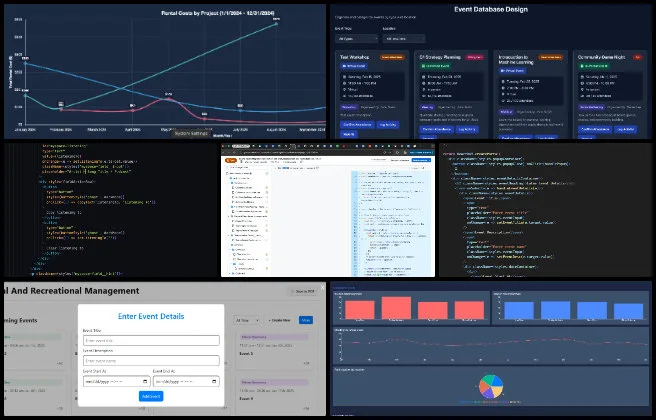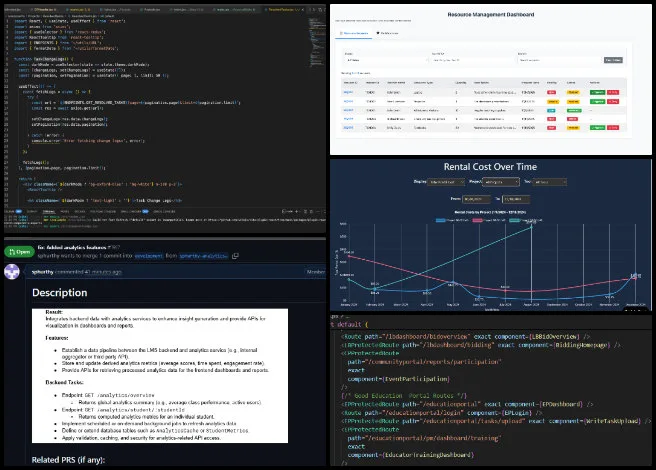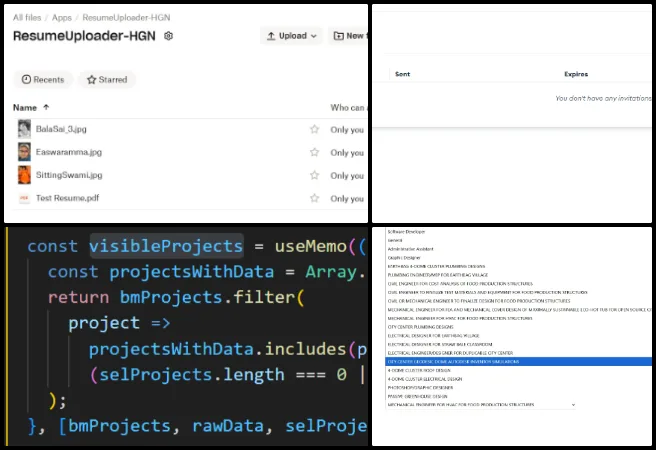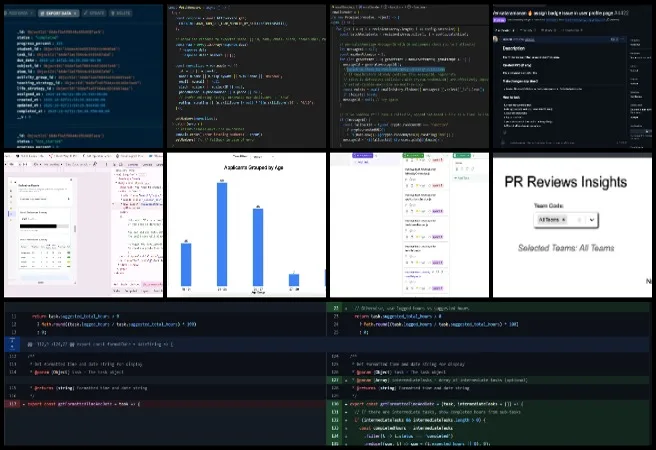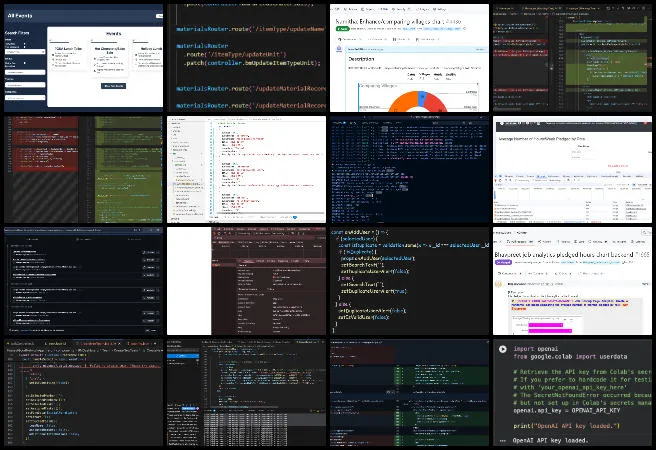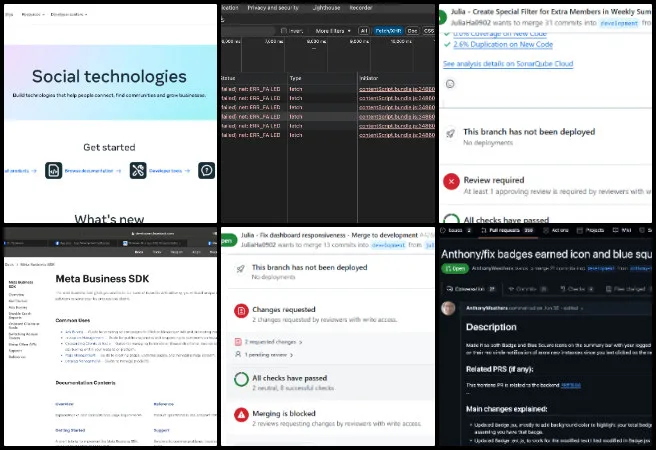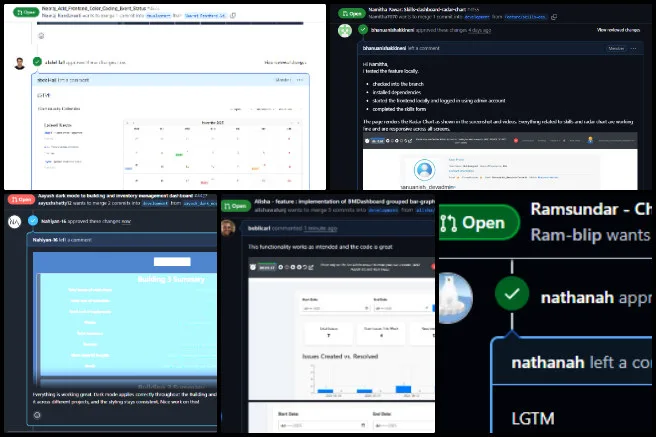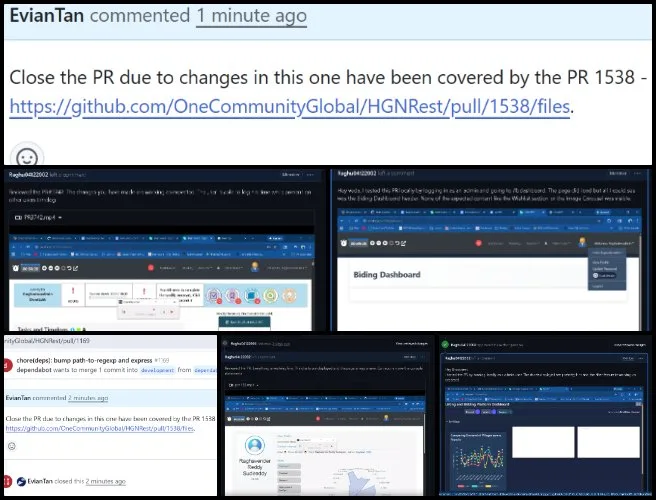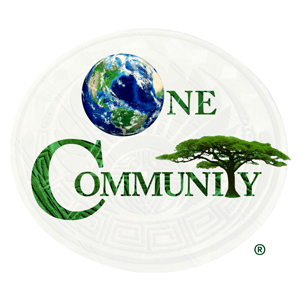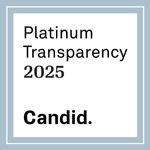Open Sourcing Sustainable Civilization Development – One Community Weekly Progress Update #662
At One Community, we are open sourcing sustainable civilization development through comprehensive and replicable solutions for food, energy, housing, education, economics, social architecture, fulfilled living, and global stewardship practices. Created by an all-volunteer team, our work focuses on developing and free sharing every component needed to build teacher/demonstration hubs around the world. By open sourcing the complete process and evolving sustainability for The Highest Good of All, we aim to regenerate our planet and help create a world that truly works for everyone.
- Here’s our project overview
- Here’s our world-change methodology
- Here’s how this becomes self-replicating
- Here’s how we are open source and free-sharing all the do-it-yourself designs
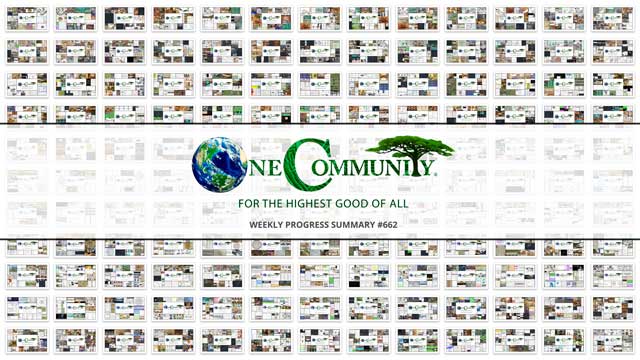
OUR MAIN OPEN SOURCE HUBS
Click on each icon to be taken to the corresponding Highest Good hub page.
One Community’s physical location will forward this movement as the first of many self-replicating teacher/demonstration communities, villages, and cities to be built around the world. This is the November 24, 2025 edition (#662) of our weekly progress update detailing our team’s development and accomplishments:
Open Sourcing Sustainable Civilization Development
One Community Progress Update #662
Video coming soon
DONATE | COLLABORATE | HELP WITH LARGE-SCALE FUNDING
CLICK HERE IF YOU’D LIKE TO RECEIVE AN EMAIL EACH WEEK WHEN WE RELEASE A NEW UPDATE
YOU CAN ALSO JOIN US THROUGH SOCIAL MEDIA
ONE COMMUNITY WEEKLY UPDATE DETAILS
HIGHEST GOOD HOUSING PROGRESS
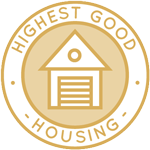 One Community is open sourcing sustainable civilization development through Highest Good housing that is artistic and beautiful, more affordable, more space efficient, lasts longer, DIY buildable, and constructed with healthy and sustainable materials:
One Community is open sourcing sustainable civilization development through Highest Good housing that is artistic and beautiful, more affordable, more space efficient, lasts longer, DIY buildable, and constructed with healthy and sustainable materials:
- Learn about: Our Upcoming Crowdfunding Campaign
- Learn about the different village models and open sourcing sustainable civilization development: 7 Sustainable Village Models
- Visit the open source portals for the first two: Earthbag Village OS Hub | Straw Bale Village OS Hub
This week, Ajay Adithiya Kumar Elancheliyan Tamilalagi (Mechanical Engineer) continued working on the ventilation system design for the Vermiculture Toilet component of the Earthbag Village. He revised his section of the report based on Jae’s feedback and performed static simulations for both models separately. He attempted simulations on the combined structural-HVAC model using two different tools, but meshing was slow and unstable, leading him to adopt a simplified geometry as an alternative approach. He also gathered photos, re-simulated the UNISTRUT assembly, redesigned the side plate to incorporate HVAC, and supported Karthik’s report by reviewing prior work and updating visuals. His ongoing work continues to support open sourcing sustainable civilization development through design refinement and cross-team collaboration. Below, you’ll find some images of this work.
Baraka Minja (Civil and Environmental Engineer Pr. Eng.) continued working on the Communal Eco-shower and Vermiculture Toilet drawings. He worked on the Duplicable City Center foundation connection concept by proposing two construction sequences, one involving bolts precast in the concrete and the other using bolts post drilled after the concrete had cured. He outlined some of the benefits and tradeoffs associated with each option and added a written explanation of these proposals to the connection concept draft report, contributing to open sourcing sustainable civilization development by developing adaptable and efficient structural solutions. See below for some of the pictures.
Derrell Brown (Plumbing Designer) continued working on the Earthbag Village 4-dome home final MEP report by reviewing feedback from the initial draft and applying updates across multiple sections. He advanced work on the final MEP report by reviewing feedback from the initial draft and applying updates across multiple sections. He reviewed the Clarity of Calculations section from the One Community Standards to align the report’s formatting with current expectations and examined the current panel schedule to verify the associated calculations before integrating them into the document. He also reviewed IMC code references to ensure consistency with the report’s definitions and overall narrative accuracy. His careful documentation supports open sourcing sustainable civilization development through clear, standardized reporting of sustainable system designs. See below for some of the pictures related to this work.
Fangting Xu (Interior Design Intern) continued working with ADA codes related to building connections for ADA 3-dome cluster of the Earthbag Village. She hosted the weekly meeting with Baraka to track his tasks and progress. And she watched Jae’s video, provided him with some feedback based on the video, and checked the level height. Also, Fangting reviewed the 2010 ADA code to see if the ADA reference draft. Her focus on accessibility and precision reflects open sourcing sustainable civilization development through inclusive and compliant design standards. See below for some of the pictures related to this work.
Karthik Pillai (Mechanical Engineer) continued work on the Vermiculture Toilet and 4-dome home components of the Earthbag Village. He worked on the four-dome cluster roof design by updating the design report in line with the comments provided by Jae and circulating the revised version for additional feedback. He reviewed specific sections of the document to ensure that the structural details, assumptions, and supporting calculations aligned with the project requirements and incorporated the suggested changes to maintain consistency across the report. For the vermiculture toilet design, he reran selected FEA simulations to obtain the necessary images for documentation and carried out design verification tasks to confirm that the structural behavior matched the expected performance criteria. His detailed coordination and analytical verification exemplify open sourcing sustainable civilization development through precision-driven engineering. The related visuals are shown below.
Loza Ayehutsega (Civil Engineer/Assistant Civil Engineer) worked on soil classifications, focusing on grouping soils based on their physical, chemical, and engineering properties. She focused on resolving the file upload issue and expanded the Soil Classification section by adding a more detailed explanation of its components. She included the field classification method in the report to align it with the required documentation standards. She also uploaded the relevant reference books from ASTM and the Unified Soil Classification System to the shared storage for accessibility. Her efforts strengthen open sourcing sustainable civilization development by ensuring a well-documented and data-informed approach to geotechnical work. See below for some of the pictures related to this work.
Rishi Chakrapani (Mechanical Engineer) continued working on the Vermiculture Toilet. He worked on the final CAD structure for the waste dumping mechanism was updated to include a pulley, and FEA was performed on the assembly to confirm that it could withstand the applied loads. The calculations report was revised to incorporate Jae’s feedback, and the document was reformatted to align with project standards. His technical updates contribute to open sourcing sustainable civilization development by improving efficiency and reliability in open-source sustainable system design. See below for some of the pictures related to this work.
DUPLICABLE CITY CENTER PROGRESS
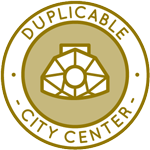 One Community is open sourcing sustainable civilization development through a Duplicable and Sustainable City Center that is LEED Platinum certified/Sustainable, can feed 200 people at a time, provide laundry for over 300 people, is beautiful, spacious, and saves resources, money, and space:
One Community is open sourcing sustainable civilization development through a Duplicable and Sustainable City Center that is LEED Platinum certified/Sustainable, can feed 200 people at a time, provide laundry for over 300 people, is beautiful, spacious, and saves resources, money, and space:
- Learn about this building and it’s function: Duplicable City Center Open Source Hub
This week, Andrew Tzu-Chien (Industrial Designer) continued working on the Duplicable City Center Dormer second-floor window. He developed the front window framing and completed the 3D modelling for the dormer window structure. He also began modifying the previous plywood layout to align with the current design, ensuring the updated structure aligns with the required adjustments. This open source Duplicable City Center project demonstrates open sourcing sustainable civilization development. For more details, refer to the image below.
Ariana Virginia Gutierrez Doria Medina (Industrial Designer) continued working on the Duplicable City Center window and door framing by focusing on completing the design of a new structure to support the window insulation. She progressed with assembling the modified parts while addressing small gaps that could affect the performance of the insulation system and ensured that each component aligned properly to maintain the intended thermal barrier across the structure. This open source Duplicable City Center project demonstrates open sourcing sustainable civilization development. See the presentation and research highlights below.

Ayushman Dutta (Mechanical Engineer) continued working on the City Center Dome Hub Connector Engineering and DIY manufacturing. He corrected issues in the assembly spreadsheet document and updated the assembly navigation sheet. He also participated in a team meeting to discuss roadblocks and clarify next steps. Ayushman documented the assembly process and created instructions explaining how to navigate the assembly spreadsheet for improved usability. He updated the assembly instructions document with formatting improvements and integrated the navigation document into the assembly process document to provide clear and complete guidance for users. This open source Duplicable City Center project demonstrates open sourcing sustainable civilization development. Review the connector analysis visuals below for more details.
Bevan Chiu (Mechanical Engineer Volunteer) continued his work finishing the City Center Eco-spa Designs. He worked on updating the plumbing pipe assembly in CAD, including performing initial calculations to determine the minimum pipe spacing required to fit within the unistrut frame assembly. He also researched potential materials and design approaches for the plumbing access panels, focusing on options such as a Baltic birch understructure and composite decking board for the exterior. In addition, Bevan created the initial CAD model for the plumbing panels based on the design concepts being considered. This open source Duplicable City Center project contributes to open sourcing sustainable civilization development. For more details, refer to the image below.
Koushik Chandra Katta (Mechanical Engineer) continued working on the Duplicable City Center design. He reviewed the status of all project rows, verified their current progress, and focused on completing the required updates for Rows 6 and 7. The associated files were organized and checked to ensure alignment with the expected specifications and design requirements. He then prepared the updated set and submitted the files to Shreyas for further integration and use within the project workflow. This open source Duplicable City Center project contributes to open sourcing sustainable civilization development. See the below image for detailed analysis of this work.
Sandesh Kumawat (Mechanical Engineer) continued developing the City Center Eco-spa Designs. He focused on revising the Unistrut-based frame structure to identify potential assembly challenges and verify structural feasibility for the Eco-Spa hot tub design. Through SolidWorks analysis, the frame geometry was refined to improve load distribution and support stable assembly while keeping practical construction considerations in view. The updated structure was then integrated with the cinder block stack foundation to form a unified hybrid base that preserves thermal mass while supporting mechanical loads. Sandesh also defined the overall spa dimensions to optimize internal volume within the assigned layout constraints. In addition, he initiated FEA pre-processing by configuring material properties, meshing parameters, and contact definitions to prepare the model for structural strength evaluation. Discover One Community’s open source Duplicable City Center, which exemplifies open sourcing sustainable civilization development. See the visuals below for a closer look.
Srujan Pandya (Mechanical Engineer) continued his work on developing the dynamic simulation setup for earthquake analysis updates for the City Center Dome Hub Connector Engineering. He carried out detailed cross-verification between SketchUp, DWG, and CAD dome models to identify missing components and confirm the accuracy of existing geometry. Srujan also revisited previously noted inconsistencies to ensure design alignment and updated the review table to clearly list all action items for team review. He coordinated with the team to maintain workflow continuity and support structured progress across the review process. The Duplicable City Center demonstrates open sourcing sustainable civilization development through open source solutions that can guide people. The images below illustrate aspects of this work.
Tianxiang Huang (Mechanical Engineer) continued working on the Duplicable City Center design. He built a simplified SolidWorks model of the hot tub to study heat conduction and estimate heat loss between the structure and the ground. He also evaluated three material configurations to compare insulation performance, including a setup with rock wool applied to both upper and lower sections, a setup with rock wool applied only to the lower section, and a setup with no insulation material. The results showed that adding rock wool reduced heat loss by about 55 percent. This open source Duplicable City Center project exemplifies open sourcing sustainable civilization development. For more details, refer to the image below.
Vineela Reddy Pippera Badguna (Mechanical Engineer) continued contributing to the Duplicable City Center Water Catchment designs. She reviewed the recharge bed concept for integration into the City Center water catchment system and examined multiple approaches for developing greener and more sustainable road and walkway designs. Vineela also reviewed the Net-zero Bathroom file to understand its layout and functional considerations, studied the Earthbag Village Septic Design file to understand system structure, and analyzed the Earthbag Village Water Harvesting and Conservation file to better understand water collection and reuse strategies. In addition, she reviewed Downspout Filters to understand their role in initial water screening within rainwater systems. This open source Duplicable City Center project contributes to open sourcing sustainable civilization development. See the updated rainwater catchment data and design visuals below.
HIGHEST GOOD FOOD PROGRESS
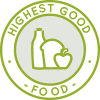 One Community is open sourcing sustainable civilization development through Highest Good food that is more diverse, more nutritious, locally grown and sustainable, and part of our open source botanical garden model to support and share bio-diversity:
One Community is open sourcing sustainable civilization development through Highest Good food that is more diverse, more nutritious, locally grown and sustainable, and part of our open source botanical garden model to support and share bio-diversity:
- Learn about the structures and open sourcing sustainable civilization development: Hoop House Hub | Aquapini & Walipini Open Source Hub
- See what we’ll be growing: Gardens & Hoop Houses | Large-scale Structures | Food Forest | TA
This week, the core team continued working on the Master Tools, Equipment, and Materials and Supplies List for the Large-scale Garden, Botanical Garden, and other Highest Good Food components. The team made comparisons between the two different Goat documents and the two different Chicken documents. Additionally, a shop document was created for TEMS, with most entries designated to be used or stored in the workshop for occasional use on other projects at different sites. The Highest Good Food initiative is a key component of One Community’s open source plans, focused on open sourcing sustainable civilization development and exemplifying the organization’s commitment through innovative design and implementation. Below are some images showcasing this work.
Anuneet Kaur (Administrator) continued her focus on the design of the Transition Food Self-sufficiency Plan components of the Highest Good food initiative. She completed the Vegan Rice, Omnivore Rice, Vegan Pasta, Omnivore Pasta, Vegan Potato, Omnivore Potato, Vegan Sweet Potato, Omnivore Sweet Potato, and Transition Kitchen webpages. Anuneet ensured each page followed the updated formatting guidelines, corrected inconsistencies, and verified SEO keyword integration across all recipe sections. Her work also contributes to open sourcing sustainable civilization development. She also reviewed titles, spacing, and layout alignment to maintain uniformity throughout the Food Web project.
Additionally, Anuneet ensured all team members were included in the live blog task and identified anyone who was missing. She reviewed Yulin’s infographic on sustainable research and provided detailed feedback. Anuneet fulfilled administrative responsibilities by editing summaries and collages for the Highest Good Society, Highest Good Education, and Core Teams, and reviewed fellow admin submissions for completeness and accuracy. The One Community model of open sourcing sustainable civilization development, exemplified by sustainably built classrooms and housing studies like these foster lasting global impact. Her recent contributions are featured in the collage below.
Chelsea Mariah Stellmach (Project Manager) continued her new focus on the Transition Food Self-sufficiency food and inventory tracking software plans. She met with Ravi to review some of Tatyana’s suggestions and discuss plans for the next phase of the software mockups. Chelsea then added comments to the Figma boards to support adjustments to functionality and usability, and followed up with Ravi to obtain a new estimate for the remaining mockup work. As an essential aspect of One Community’s open source goals, the Highest Good Food initiative supports open sourcing sustainable civilization development. The following images provide a view of her contributions.
Falguni Sakpal (Volunteer Architectural Designer and Planner) continued initiating render development for the Aquapini and Walipini Master Plan of the Highest Good Food initiative. She continued work on the Aquapini and Walipini Master Plan and Related Website Content Updates task. Falguni reviewed the assigned sections across all three main documents and responded to comments from Jae and Shivangi to clarify rendering expectations for plans, elevations, and sections. Her work supports open sourcing sustainable civilization development by strengthening the visual clarity and consistency needed for these open-source resources. She gathered visual references for the rendering style, studied existing plan and section examples, and reviewed the original AutoCAD base files to understand layer organization and drawing structure.
Falguni exported and cleaned the required plan layers, set up the rendering workflow, and began the first draft of the rendered plan. The work focused on establishing a consistent visual approach for the upcoming base renderings while ensuring alignment with One Community’s documentation and formatting standards. The Highest Good Food initiative is a key part of One Community’s open source platform, focused on sustainable and participatory development while open sourcing sustainable civilization development. See below for pictures related to this work.
Gayatri Pandkar (Architect) continued writing content for the various components of the Aquapini and Walipini aspects of the Highest Good Food initiative. She worked on designing the people space for the Walipini 3 structure by reviewing the layout and identifying needed elements. Gayatri gathered the SketchUp plants and trees from the project list and prepared them for the model. She also placed selected trees in the SketchUp model and continued developing the concept design sketch with the main ideas for the layout. The Highest Good Food initiative is a key part of One Community’s open source platform, focused on sustainable and participatory development while open sourcing sustainable civilization development. Visual examples from her work are presented below.
Japneet Kour (Volunteer Architect) continued contributing to the Highest Good Food initiative. She worked on compiling the diversity of plants from the previous SketchUp file into the current Walipini 1 file, added more plant diversity based on feedback given, reviewed the placement of specific plant groups to align with project requirements, and corrected multiple elements in the SketchUp model for Walipini #1, the Frost-Free Arid Zone Desert House. The Highest Good Food initiative is a key part of One Community’s open source platform, focused on sustainable and participatory development while open sourcing sustainable civilization development. Visual examples from her work are presented below.
Jay Nair (BIM Designer) continued developing the Aquapini and Walipini Planting and Harvesting documents. He worked on the lighting energy calculation for Walipini 1, updating the data and verifying the figures needed for each zone. Jay also focused on standardizing the document’s format to match the required layout, organizing sections, refining headings, and ensuring consistency so the document aligns with the project’s presentation standards. The Highest Good Food initiative is a key part of One Community’s open source platform, focused on sustainable and participatory development while open sourcing sustainable civilization development. See below for pictures related to this work.
Nitin Parate (Architect) continued contributing to the Aquapini and Walipini renders and layout graphics. Nitin focused on the Walipini 3 plan, beginning with a review of the layout and planting scheme to understand the design requirements. The needed JPG and PDF files were extracted for reference and organized for the next stages of production and rendering. The base layer for the plan was prepared, and different planting layers were applied to build the layout further and align it with the project’s planting scheme. The Highest Good Food initiative is a key part of One Community’s open source platform, promoting regenerative and participatory development while open sourcing sustainable civilization development. Images below showcase his contributions.
Pallavi Deshmukh (Software Engineer) continued working on the Aquapini and Walipini Planting and Harvesting web details. She updated the Walipini #2 page with content provided by Silin and Junyi Shi, including revisions to text, links, and images before submitting the updated version for Jae’s review. Pallavi completed the Walipini #2 updates and continued work on Walipini #1 and Zenapini #2 using content from Gayatri. She created new content for Blog 661 and incorporated feedback from teammates. Pallavi also scheduled interviews for the upcoming week. In alignment with One Community’s open source objectives, the Highest Good Food project integrates open sourcing sustainable civilization development into a larger vision of regenerative living. Her contributions are highlighted in the collage below.
Ravi Kumar Sripathi (Software Engineer) continued developing the Food Procurement and Storage software platform, enhancing features related to inventory tracking, recipe management, and food utilization. Ravi focused on expanding the inventory, agriculture, and animal-management workflows to improve tracking and production planning across the One Community hub. His updates also support open sourcing sustainable civilization development by improving transparency and usability across food-management systems. A pie chart visualization was developed to show how harvested ingredients are used, providing clearer insight into food allocation and potential waste. This work further aligns with open sourcing sustainable civilization development as the platform becomes more accessible and informative for users. Additional updates were outlined for the animal-management system, including buttons to order feed, supplemental nutrition, and other supplies needed for breeding, illness, and general care. Progress was also made on a financial tracking feature that compares animal output to the cost of raising them, supporting more informed planning around livestock operations. Work continued on features related to produce processing, including recipe pathways for turning surplus meat into products such as tallow, jerky, and other preserved items, aligning these workflows with existing harvest-processing tools. The Highest Good Food initiative is a key part of One Community’s open source platform, focused on sustainable and participatory development while open sourcing sustainable civilization development. See below for pictures related to this work.
Shivangi Varma (Architectural Designer and Planner) continued the redesign of the Highest Good Food overall presentation, currently focused on the Aquapini and Walipini masterplan render. She updated the masterplan render for the HGF project based on the loom video feedback she received and continued detailing the Aquapini, Walipini, and Zenipini structural layout renders by adding plant and passage details. Shivangi refined the Aquapini masterplan using the 2D layout and plant lists, and the Zenipini interior layout showing the extent of green landscape and planting beds. The Highest Good Food initiative plays a leading role in One Community’s open source platform by promoting sustainable and participatory development, focused on open sourcing sustainable civilization development. Below are visuals highlighting this work.
HIGHEST GOOD ENERGY PROGRESS
 One Community is open sourcing sustainable civilization development through Highest Good energy that is more sustainable, resilient, supports self-sufficiency and includes solar, wind, hydro and more:
One Community is open sourcing sustainable civilization development through Highest Good energy that is more sustainable, resilient, supports self-sufficiency and includes solar, wind, hydro and more:
- Learn about the open source sustainable-energy foundations: Solar, Hydro, and Wind
- Explore our research into the most sustainable products and companies for saving water and energy: Insulation, Eco-laundry, Lightbulbs and Light Bulb Companies, Doors and Door Companies, Windows and Window Companies, Toilets, Faucets and Faucet Accessories, Urinals, and more.
This week, the core team continued contributing to the Highest Good Energy initiative. They worked on the Energy Needs Analysis Spreadsheet by locating several energy-related pages, verifying values where possible, and adding copies of the information to the primary document. The core team corrected a number of entries, checked that all linked cells functioned as intended, and applied formatting adjustments to clearly distinguish needs tables from cost tables. The Highest Good Energy initiative plays a leading role in One Community’s open source platform by promoting sustainable and participatory development, focused on open sourcing sustainable civilization development. Below are images related to this project.
HIGHEST GOOD EDUCATION PROGRESS
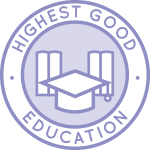 One Community is open sourcing sustainable civilization development through Highest Good education that is for all ages, applicable in any environment, adaptable to individual needs, far exceeds traditional education standards, and more fun for both the teachers and the students. This component of One Community is about 95% complete with only the Open Source School Licensing and Ultimate Classroom construction and assembly details remaining to be finished. We’ll report on the final two elements to be finished as we develop them. With over 8 years of work invested in the process, the sections below are all complete until we move onto the property and continue the development and open sourcing process with teachers and students – a development process that is built directly into the structure of the education program and everything else we’re creating too:
One Community is open sourcing sustainable civilization development through Highest Good education that is for all ages, applicable in any environment, adaptable to individual needs, far exceeds traditional education standards, and more fun for both the teachers and the students. This component of One Community is about 95% complete with only the Open Source School Licensing and Ultimate Classroom construction and assembly details remaining to be finished. We’ll report on the final two elements to be finished as we develop them. With over 8 years of work invested in the process, the sections below are all complete until we move onto the property and continue the development and open sourcing process with teachers and students – a development process that is built directly into the structure of the education program and everything else we’re creating too:
- Program Overview: Education Open Source Hub
- How the components work together in designing human orchestrated eco-abundance: How to use the Education for Life Program
- Lesson Plans for Life – Lesson Plans How-to
- Foundations of Outstanding Leaders, Teachers, and Communicators
- Curriculum for Life
- Teaching Strategies for Life
- Learning Tools and Toys for Life
- Evaluation and Evolution
This week, Prudhvi Marpina (Data Analyst) continued developing the Highest Good Education software platform, concentrating on Phase 4: marketing, promotion, and administrative activities. He worked on HGN Phase 4 software management by sending Slack messages to developers for updates on pending tasks, reviewing Deliverable 2 action items to check pull request titles and labels, updating Figma images, and assigning hours for newly claimed tasks. He also updated Jae on pull requests needing changes and communicated label corrections to developers. As part of the marketing and promotion work, Prudhvi updated the weekly tracker data in the social media dashboard and Bluesky sheets, reviewed last week’s analytics, and scheduled next week’s posts in Buffer. In addition, he contributed to OC Administration by updating Blog 661, reviewing each admin’s weekly contributions, and making updates in the blog and summaries document. Through these activities, he supported One Community’s commitment to open sourcing sustainable civilization development. The images below highlight his contributions.
HIGHEST GOOD SOCIETY PROGRESS
 One Community is open sourcing sustainable civilization development through a Highest Good society approach to living that is founded on fulfilled living, the study of meeting human needs, Community, and making a difference in the world:
One Community is open sourcing sustainable civilization development through a Highest Good society approach to living that is founded on fulfilled living, the study of meeting human needs, Community, and making a difference in the world:
- Read the Highest Good society overview: Highest Good Society
- Learn about the model for fulfilled living and sharing: A Day in the Life
- Learn about the 4 economic models: RBE | For-profit | Non-profit | Entrepreneurship
- Learn about our open source community collaboration and management software: The Highest Good Network
This week, the core team completed over 42 hours managing volunteer work reviews, handling emails, overseeing social media accounts, supporting web development, identifying new bugs, and integrating bug fixes for the Highest Good Network software. They also interviewed and onboarded new volunteer team members. Additionally, they produced and integrated the video above, highlighting how open sourcing sustainable civilization development serves as the foundation of One Community’s broader mission. The following images showcase highlights of this work.
Jaiwanth Reddy Adavalli (Project Manager) continued developing the Job Applicants page and key components of the Highest Good Network, tracking updates in the software team management documents to assign, monitor, and support task status. He worked on the Phase 2 and Phase 3 Dashboards by testing multiple components in the HGN software. He also created new action items to develop new components in those dashboards. He tracked updates in software team management documents to support task management. As a member of the pull request review team, Jaiwanth reviewed submissions from the volunteer team assigned to him. This work supports One Community’s commitment to open sourcing sustainable civilization development. The images below highlight his contributions.
Yagna Reddy Badvel (Data Analyst and Team Administrator) continued working on the Summary Dashboards and Weekly Report page on the Highest Good Network. He completed a full audit of the Phase 2 “Materials, Equipment, Tools, and Project Tracking System” tab in the HGN Bugs & Features sheet, checking for missing fields, incorrect dropdown usage, outdated status values, and validating escalation levels to ensure urgent tasks were marked correctly. He fixed formatting inconsistencies, cleaned up broken or duplicated Google Doc bookmark links, refined task descriptions, and updated filtering logic to match the current project structure. In addition to Phase 2 tracking, Yagna completed his regular admin responsibilities by reviewing volunteer summaries for formatting and accuracy, checking media folders, adding tracking tables where needed, providing feedback through the weekly reporting process, verifying SEO and image requirements, updating WordPress entries, coordinating fixes before the deadline, and organizing folders and documents to prepare everything for the next cycle. This work supports One Community’s commitment to open sourcing sustainable civilization development. The images below highlight his contributions.
ADMINISTRATION TEAM
The Administration Team’s summary, which covers their work on the Highest Good Network, was managed by Prudhvi Marpina (Data Analyst) and includes Anusha Gali (Software Engineer), Ashutosh Mishra (Software Engineer), Divanshu Bakshi (Team Admin), Indra Anuraag Gade (Software Engineer and Team Administrator), Keerthana Chitturi (System Administrator), Mridul Bhushan (Volunteer Project Strategy Analyst and Team Administrator), Neeharika Kamireddy (Data Analyst), Olawunmi “Ola” Ijisesan (Administrative and Management Support), Olimpia Borgohain (Data Analyst and Team Administrator), Priyanshi Sharma (Data Analyst and Team Administrator), Rachna Malav (Data Analyst), Rajeshwari Bhirud (Administrator), Rishitha Adepu (Administrator), Sai Suraj Matta Veera Venkata (Business Data Analyst), Sayantan Paul (Volunteer Frontend Tester and Software Team Administrator), and Sudarshan Raju Chintalapati Venkata (Data Analyst). The Administration Team supports the Highest Good Network, a tool designed to track and measure progress while developing systems that contribute to open sourcing sustainable civilization development. Through administrative support, documentation, testing, training, recruiting, analytics, and content management, the team helps advance this mission, aligning with One Community’s vision of building a replicable and sustainable future model.
This week, Anusha completed Level 2 testing across the HGN and HGNRest systems, validating dozens of pull requests, requesting updates for UI, backend, and functional issues, updating tracking files, and supporting administrative workflows. Ashutosh optimized latency for the 3D virtual assistant by improving caching logic, added new API endpoints, completed Timelog Administrator tasks, tested multiple models, and advanced LCEL-related features. As part of this work, he contributed to open sourcing sustainable civilization development by strengthening infrastructure that supports wider system reliability. Divanshu processed Mastodon analytics with Python scripts, updated the Master Data sheet and Volunteer Tracker, posted four Mastodon updates, and documented two platform-related issues.
Indra completed Blog #661 for the Code Crafters Team, updated Twitter analytics, built an ML pipeline with 12 models and 18 engineered features, produced technical documentation, and contributed new items to the Bugs & Features tracker. Keerthana reviewed weekly summaries, updated Step 2 and Step 4 documents, prepared the weekly blog, and added Phase 3 action items. Mridul refined Moonfall Team submissions, prepared collage alt text, finalized the WordPress blog version, reviewed Sudarshan’s admin submission, and validated HGN Phase 2 document entries while strengthening content that supports open sourcing sustainable civilization development.
Neeharika coordinated software team tasks, followed up on assignments, tested multiple pull requests, logged new bugs, completed admin duties, and verified updates in corrected documents. Ola prepared administrative folders, organized workspaces, managed Pinterest scheduling, created new content, and uploaded her weekly tasks with images. Olimpia updated LinkedIn analytics KPIs, completed senior admin review checks, resolved documentation comments, handled warnings and blue square notifications, and scheduled next week’s LinkedIn posts. Priyanshi continued Phase 2 PR testing, identifying chart and filter issues, verifying dashboard logic, documenting findings, and refining her testing process. Rachna reviewed older tasks, emails, and SEO pages and monitored hiring workflow activity. Rajeshwari managed Blog #661 administration by reviewing summaries, providing feedback, updating SEO content, and documenting detailed HGN Dashboard test cases, helping reinforce content aligned with open sourcing sustainable civilization development.
Rishitha updated bios, uploaded Threads content, added raw data to the dashboard, updated the volunteer tracker, and created documentation and videos. Sai Suraj completed Facebook and Instagram analytics updates, built training materials for the Volunteers Guide hub, scheduled content, maintained documentation, and completed administrative work. Sayantan continued Level 1 testing across multiple PRs, verified frontend and dashboard behaviors, and reported Team Skye’s weekly contributions. Sudarshan managed the Alpha Software Team blog, completed SEO and collage updates, reviewed Phase 2 PRs, added new tasks for bugs and enhancements, validated dashboard data, and tested merged PRs 4254, 4277, and 4253. To learn more about how this work supports One Community’s vision of open sourcing sustainable civilization development, visit the Highest Good Society and Highest Good Network pages. Highlights of the team’s contributions are shown in the collage below.
GRAPHIC DESIGN TEAM
The Graphic Design Team’s summary includes Qinyi Liu (Graphic Designer), and Yulin Li (Graphic Designer) who focused this week on creating graphic designs that support open sourcing sustainable civilization development.
This week, Qinyi created and refined AI-generated characters, updated posters and social media images, revised earlier designs for visual consistency, and compared multiple generation tools for open sourcing sustainable civilization development, noting differences in their ability to interpret reference images and maintain consistent art style. Yulin revised five social media images based on feedback, posted a software team collaboration announcement, managed shared assets, and participated in review discussions for open sourcing sustainable civilization development, and she used these efforts to support visual communication and coordination tasks. Their efforts highlight open sourcing sustainable civilization development. See the Highest Good Society pages and the collage below for examples of their work.
HIGHEST GOOD NETWORK PROGRESS
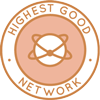 One Community is open sourcing sustainable civilization development through open source Highest Good Network® software that is a web-based application for collaboration, time tracking, and objective data collection. The purpose of the Highest Good Network is to provide software for internal operations and external cooperation. It is being designed for global use in support of the different countries and communities replicating the One Community sustainable village models and related components.
One Community is open sourcing sustainable civilization development through open source Highest Good Network® software that is a web-based application for collaboration, time tracking, and objective data collection. The purpose of the Highest Good Network is to provide software for internal operations and external cooperation. It is being designed for global use in support of the different countries and communities replicating the One Community sustainable village models and related components.
- Learn about our open source community collaboration, open sourcing sustainable civilization development, and management software: The Highest Good Network
This week, the core team tested HGN pull requests and confirmed 10 fixed PRs. This effort highlights One Community’s commitment to open sourcing sustainable civilization development.
The following PRs were not fixed: the Blue Square CC feature, the specific application page template form for the application and job posting page, the added counter on the CC list button for Blue Square, and the dark mode update for analytics with invalid date range handling. They were not able to test the Job Posting Page Analytics frontend PR for creating a horizontal bar graph showing the hits-to-applications ratio because there was no data on the Main branch. This work strengthens One Community’s mission of open sourcing sustainable civilization development. See the Highest Good Society and The Highest Good Network pages, and the collage below, for an overview of the team’s contributions.
ALPHA SOFTWARE DEVELOPMENT TEAM
The Alpha Software Team, working on the Highest Good Network software, was managed by Lin Khant Htel (Frontend Software Developer). The team includes Maneesh Buddha (Software Developer) and Nikita Kolla (Full Stack Developer). The Highest Good Network software is a key part of sustainable and free-shared eco-solutions, helping track and measure progress toward open sourcing sustainable civilization development. The software supports social architecture, construction, production, and maintenance processes that contribute to the open source project and resilient ecosystems. Designed to be portable and scalable, the Highest Good Network software is well suited for off-grid and sustainable living communities. This project reflects One Community’s open source commitment to advancing the idea of open sourcing sustainable civilization development.
This week, Maneesh worked on the Select Category filter issue in the Job Posting page by identifying why the list displayed no categories and adjusting the frontend logic to ensure the data loaded correctly. His troubleshooting process also aligns with open sourcing sustainable civilization development by strengthening the reliability of shared systems. He also focused on the reorder function for job items by reviewing the save logic, checking the API request behavior, examining the authorization header handling, preparing a separate branch to isolate the changes, testing the related components, and gathering screenshots to document his progress.
Nikita addressed skill gaps in MongoDB while resolving issues in the codebase by analyzing how tests interacted with the database and identifying conditions that caused certain logic paths to be skipped, which affected expected test outcomes. During this work, she encountered an additional issue related to core team missed hours, highlighted by an error indicating that a MongoDB lookup using a pipeline could not specify both localField and foreignField, which guided further debugging of the core team additional hours logic. See the Highest Good Society and Highest Good Network pages for more on how this contributed to the idea of open sourcing sustainable civilization development. See the collage below to view the team’s work.
BINARY BRIGADE SOFTWARE DEVELOPMENT TEAM
The Binary Brigade Team, presenting their work on the Highest Good Network software, was managed by Nikhil Routh (Software Engineer) and included Kanishk Agarwal (Software Engineer), Apoorva Jain Ramapura Prashanth (Software Engineer), Deep Shah (Software Engineer), Ramsundar Konety Govindarajan (Software Engineer), Harsha Rudhraraju (Software Engineer), Xinyi Zhou (Developer), Sourabh Bagde (Software Developer), Taariq Mansurie (Full-Stack Developer), Sumedh Kumar (Full-Stack Developer), Aswin “Tony” Kanikairaj (Software Engineer), and Amalesh Arivanan (Software Engineer). The Highest Good Network software is our tool for managing and objectively measuring progress, ensuring that all contributions are tracked and aligned with our mission, modeling, and open sourcing sustainable civilization development.
This week, Amalesh implemented the Phase 2 Summary Dashboard with responsive KPI tiles, a weekly tasks line chart, date range filtering, backend integration for task grouping and KPI aggregation, timezone handling, and error handling, and also resolved merge conflicts related to the duplicate task feature and scheduling controller while documenting and tracking his work. Apoorva updated the email templates UI by moving from card-based layouts to a tabbed interface, fixed image uploads in TinyMCE, optimized search debounce behavior, added client-side sorting, and investigated a blank email issue by tracing HTML flow and identifying backend authentication errors as the cause while preparing a fresh development setup. Aswin completed Phase 3 Visualization work by adding routing and subpages to the Participation Report, restoring and fixing the calendar layout with event indicators, resolving dark mode visibility issues, building comparative charts, converting remaining global CSS to modules, and validating workflow behavior across components, contributing to overall progress aligned with open sourcing sustainable civilization development.
Deep fixed chart legend visibility and dark mode theming issues, addressed low-contrast and rerender problems after theme changes, and corrected the “Belongs to” selector behavior to stop auto-adding tags while pending further backend testing. Harshavarma developed calendar views for month, week, and day, added an interactive add-task popup, improved responsive layouts, handled overlapping event rendering, aligned UI with existing styles, and prepared hooks for future backend integration while validating edge cases. Kanishk integrated backend and frontend for the Attendance and No-Show Tracking System, resolved a MongoDB connection string issue, reviewed the Event model and filtering APIs, and built the database design page with event cards and routing. Nikhil progressed the CSS Modules migration across multiple components, reviewed related PRs, validated backend fixes for MongoDB timeouts, helped define backend data flow and database structure for a new feature, and assisted in analyzing a production data deletion incident by contributing to root cause identification and suggesting DB audit monitoring and real-time deletion alerts as part of broader efforts supporting open sourcing sustainable civilization development.
Ram addressed review comments on the PR Review Team Analytics Dashboard, worked through merge conflicts in older PRs, investigated a UI issue where usage records were not rendering despite valid API responses, and encountered development branch access errors. Sourabh enhanced the MySpace auto-poster by fixing scheduling logic to prevent post overwrites, improving dark mode styling, validating form fields, and aligning the scheduling UI with the intended design. Sumedh added a Material Usage Record doughnut chart to the BM Dashboard with associated UI integration and styling, submitted a pull request, and continued investigating an API issue in the DailyActivity Log while resolving dark mode bugs. Taariq fixed filter issues on refresh, resolved merge conflicts and lint problems related to a node upgrade, advanced updates to weekly summary email user logic, tested email functionality, investigated permission page UI inconsistencies, and prepared archived projects changes for review. Xinyi fixed the “view issues” button routing, updated the dropdown menu to include and format the Team option, improved dark mode compatibility, addressed review feedback, and reviewed teammates’ pull requests. See the Highest Good Society and Highest Good Network pages for more information on how this work models open sourcing sustainable civilization development. The collage below shows images of their work.
BLUE STEEL SOFTWARE DEVELOPMENT TEAM
The Blue Steel Software Team, working on the Highest Good Network software, was managed by Divanshu Bakshi (Product Manager), and includes Linh Huynh (Software Engineer), Som Ramnani (Software Engineer), and Sheetal Mangate (Software Engineer). This week, Linh focused on the educator-side feature for displaying the list of finished tasks reported by students, reviewing backend and frontend structures related to the task submissions list as part of open sourcing sustainable civilization development. He analyzed endpoint behavior and confirmed how student submissions populate the dynamic table, examined the returned fields required for the educator view including student name, task name, submission type, submission status, submission date, and review links, and reviewed query filters for status, student, and course to determine how they should integrate with the UI layout. Linh also evaluated prior developer changes, identified areas requiring correction, verified routing expectations, and prepared the project for implementing logic to detect and tag late submissions so the interface can properly load, filter, and display student task completion records. Som worked on PR 4228 to fix a Figma mismatch in the CPDashboard by adding the missing “Ending After” date picker to the search filters, implemented state management to handle the selected date to improve event filtering, resolved UI inconsistencies on the live site, and created the related PR. Som also revisited PR 4215 to resolve merge conflicts in package.json and yarn.lock caused by unintended dependency upgrades from npm, reverted both files to correct versions, reinstalled node modules, and switched the workflow from npm to yarn to maintain consistent lockfile behavior and align dependencies with development. Sheetal explored Bitwarden for storing secrets and API keys, created an account, added secrets for Reddit, reviewed the developer guide for retrieving stored values, committed code for the frontend autoposter, encountered a block due to a Husky pre-commit hook, bypassed the issue using the no-verify option, and reported continued difficulty with the commit process despite messages indicating all checks passed while continuing efforts aligned with open sourcing sustainable civilization development. The collage below shows images of their work.
CODE CRAFTERS SOFTWARE DEVELOPMENT TEAM
The Code Crafters Team, covering their work on the Highest Good Network software, was managed by Vivek Chandra (Software Engineer) and includes Ajay Naidu (Software Engineer), Akshith Kumar Reddy Balappagari Gnaneswara (Software Engineer – Full Stack), Juhitha Reddy Penumalli (Software Engineer), Sphurthy Satish (Software Engineer). The Highest Good Network software is how we’ll manage and objectively measure our progress in open sourcing sustainable civilization development through our social architecture, construction, production, and maintenance efforts, while supporting widespread and lasting eco-lifestyle access.
This week, Ajay refined chart behavior by adjusting data label rendering to prevent overlap when viewing all projects, corrected label display when switching between cost and percentage values, verified the updates against requested features, pushed the changes to a new branch, addressed failing checks, and added a clickable magnifying-glass search icon that improves search visibility and usability. Akshith continued work on the Phase 4 PM Educator Training Dashboard frontend by implementing database-driven functionality that makes the dashboard dynamic, ensuring certification profile updates appear accurately across systems, and reviewing various interaction scenarios. Juhitha worked across Phase 4 and Phase 2 by implementing the Task Progress Indicator and Status Updates, preparing backend and frontend pull requests, adding a placeholder page for routing to unit and subject views, resolving CSS issues with dashboard bar graphs, completing the donut chart and subject bar indicators, refining navigation between subjects and units, integrating mock data with student progress components, contributing to the Project Manager Resource Management Dashboard with routing, tabbed interfaces, component styling, and initial table layout, and updating routing logic and tab structures, with her contributions aligning well with open sourcing sustainable civilization development. Sphurthy completed analytics backend integration for the HGNRest application by creating a StudentMetrics model, building an analytics service to compute and cache metrics, implementing endpoints for cluster-wide and per-student analytics with appropriate headers, adding a daily cron job to refresh metrics, and updating server files to register routes and background jobs. Vivek developed the controller to retrieve task change logs after reviewing the codebase, created a component for resolved tasks requiring backend integration, investigated an issue where the API was not being triggered despite appearing correctly set up, and wrote and pushed the updated README for the education portal. These contributions strengthen One Community’s mission and commitment to open sourcing sustainable civilization development. The collage below shows an overview of this team’s work.
DEV DYNASTY SOFTWARE DEVELOPMENT TEAM
The Dev Dynasty Team’s summary, covering their work on the Highest Good Network software, was managed by Prem Vora (Software Developer) and includes Adithya Cherukuri (Volunteer Software Engineer), Aditya Gambhir (Software Engineer), Deekshith Kumar Singirikonda (Developer), Manvitha Yeeli (Software Engineer), Nahiyan Ahmed (Full-Stack Software Developer), Sriamsh Reddy (Software Engineer), Neeraj Kondaveeti (Software Engineer) and Vamsidhar Panithi (Software Engineer). The Highest Good Network software is how we’ll manage and objectively measure our processes for open sourcing a better world for us all through our social architecture, construction, production, and maintenance processes. This progress supports One Community in open sourcing sustainable civilization development.
This week, Nahiyan reviewed PR 4427 to validate dark mode behavior in the Building and Inventory Management Dashboard by checking theme toggling, layout consistency, and alignment with the existing code structure. Adithya worked on backend and frontend components for Job Posting Analytics and the Listing and Bidding Platform by completing aggregation logic and caching for enhanced role-based visualization, implementing chart integration, and preparing and running payment creation tests. Aditya carried out quality assurance across multiple areas by reviewing frontend and backend pull requests for the Skills module, Paid Labor Cost chart, and project components, testing dark mode behavior, analyzing API activity, and identifying issues with date filters, cost display, and data flow. Deekshith developed authentication and analytics components by implementing PermissionWatcher for session monitoring, useCountdown for forced logout handling, and AttendanceStatistics for visualizing event data with Recharts and Redux integration. Manvitha completed the Student Dashboard Timer and the Resource Request backend module by building timer controls, fixing synchronization and display issues, integrating backend API actions, and implementing educator and project manager request workflows with validation, authorization, and filtering. Neeraj enhanced the Community Calendar by adding filters for type, location, and status, updating layout behavior for both themes, improving tooltip and modal interactions, and refining data label visibility in the Job Posting Analytics chart for dark mode readability, contributing to work that aligns with open sourcing sustainable civilization development. Prem also worked on the Student Dashboard Timer and Resource Request backend module by building a countdown system with start, pause, resume, reset, and adjustment functions, resolving alignment and synchronization issues, integrating API connections for timer actions, and adding backend endpoints for request creation, retrieval, and updates with role-based authorization. Sriamsh implemented backend and frontend components for the Production-Linked Dev Account creation feature, including an endpoint for identity verification, validation logic, password hashing, an audit log system with timestamps and IP tracking, and frontend validation and error handling for the new signup interface. Vamsidhar improved dark mode compatibility across dashboard components by updating the Supplier Performance Graph and Project Status Donut Chart, adjusting background, label, and legend behavior, resolving layout and responsiveness issues, and completing related work under PRs 3405 and 3469. See the Highest Good Society and Highest Good Network pages for more on how this relates to our mission of open sourcing sustainable civilization development. Explore some of the team’s work in the collage below.
EXPRESSERS SOFTWARE DEVELOPMENT TEAM
The Expressers Team’s summary, which covers their work on the Highest Good Network, was managed by Rahul Trivedi (Software Engineer) and includes Casstiel Pi (Software Engineer), and Meenashi Jeyanthinatha (Full-Stack Developer). This contribution supports One Community’s mission of open sourcing sustainable civilization development.
This week, Casstiel finished the pull request for the “Fix Legend Color Change Bug on Injury Severity by Projects Chart” and began working on a new issue: fixing a page error that occurs when clicking lesson elements, including adding dark mode support. After analyzing the error logs, the cause was identified as the Tooltip component not receiving valid active, payload, or label props, resulting in payload being undefined and triggering a .forEach call on an undefined value within CustomTooltip. Work is ongoing to resolve this issue. During this process, the login functionality became non-functional due to a “user not found” error when attempting to log in as admin, and efforts are being made to address this problem before continuing further with the assigned bug. This contribution supports One Community’s goal of open sourcing sustainable civilization development.
Meenashi updated the Dropbox App Folder access for development users from Only You to 1/500, enabling the app to connect and retrieve the authorization code. Using this code, the refresh token was generated and stored, and file uploads using the token are functioning as expected. The refresh_token, client_id, and client_secret were moved to environment variables, and files are now uploading to the designated Dropbox App Folder, with visibility of the uploaded files still needing verification. Validation was added to restrict uploads to files under 5MB and to allow only .doc, .docx, .pdf, .jpeg, and .png formats. The job form was added for some entries, and the jobForms missing in Adreplies were re-added after it was identified that previously added forms had been deleted unexpectedly, and all required jobForms have been restored. This contribution supports One Community’s mission of open sourcing sustainable civilization development. Rahul focused on resolving merge conflicts in PR 4212, addressing repeated errors related to file names and naming conventions, and investigating issues that continued due to the number of files involved. The work also included reorganizing the src/Reports folder by renaming several .css files to align with the project’s .module.css requirements. In addition to development tasks, team management responsibilities were handled, including reviewing team photos, summaries, and videos, and participating in a meeting with Anne Taylor to provide guidance on ongoing issues. See the Highest Good Society and Highest Good Network pages for more on how this work contributes to open sourcing sustainable civilization development. See the collage below to view the team’s work.
LUCKY STAR SOFTWARE DEVELOPMENT TEAM
The Lucky Star Team’s summary, covering their work on the Highest Good Network, was managed by Keerthana Chitturi (System Administrator) and Sohail Uddin Syed (Software Engineer). The team includes contributions from Abhishek Jain (Software Engineer), Aryan Rachala (Software Engineer), Chirag Bellara (Software Engineer), Durga Venkata Praveen Boppana (Software Engineer), Shashank Madan (Software Engineer), Shravya Kudlu (Software Development Engineer), Veda Bellam (Software Engineer) and Venkataramanan Venkateswaran (Software Engineer). Their work supports One Community’s goal of open sourcing sustainable civilization development through cross-functional software development.
This week, Abhishek completed the foundational infrastructure for the Code Coverage Improvement Initiative, transitioning the project from planning to implementation. He finalized the ClickUp board for tracking test coverage improvements across repositories and prepared the HGNRest backend PR (#1754) for merge, which implements automated GitHub Actions to enforce 60% code coverage and zero linting errors. While advancing the frontend PR (#4114), he identified critical performance bottlenecks in the HighestGoodNetworkApp repository’s GitHub runners that were causing pipeline delays. This discovery led to a strategic rollout plan to merge HGNRest first, then resolve the runner issues before proceeding with the frontend implementation. This technical coordination supports open sourcing sustainable civilization development. Aryan focused on resolving an issue in the HGN Questionnaire Dashboard where the “Show your team members” section on the Top Community Member page was not displaying data. He identified the cause as a mismatch between the API response structure and the component’s data expectations. He updated the component logic and refactored the Redux selector to correctly extract and render the team member information, also reporting missing testing accounts and unavailable admin logins to Jae. This debugging and communication effort contributes to open sourcing sustainable civilization development.
Chirag worked on fixing the default filter selections for the PR Analytics graphs screen, completed the updates, and merged them into pull request 4394. He also investigated a link issue between the “Longest Open Issues” and “Quantity of Materials Used” graphs and analyzed the Bar chart implementation to determine the root cause of errors, preparing to commit the related fixes after validation. These enhancements support open sourcing sustainable civilization development. Durga resolved issues identified during the code review, added a side navigation bar in the Evaluation Results section, updated mobile and report views, obtained approval to convert CSS files to module CSS, and prepared the analytics pull request for merging. He also documented next steps, including resolving merge conflicts and coordinating frontend–backend integration once the necessary APIs are ready. This progress contributes to open sourcing sustainable civilization development. Shashank fixed errors in the update and delete flows for intermediate tasks on the frontend, added a delete modal, and updated the student profile to display intermediate tasks. He implemented mark-as-done functionality and progress bars for intermediate tasks in the student view and linked the parent task’s progress and status changes to its child tasks. This backend and frontend progress supports open sourcing sustainable civilization development.
Shravya worked on Phase 4 – Class-Wide Performance Report Generation, identifying the data required, designing a scoring system, and creating a mathematical formula to evaluate performance levels as Excellent, Satisfactory, or Needs Improvement. Her work included detailed planning, implementation of foreign key logic, and verification of accurate student retrieval by group. These efforts contribute to open sourcing sustainable civilization development. Sohail advanced the email threading implementation from Step 5 to completion by wiring the generated messageId, inReplyTo, and references values into Nodemailer so all thread-related headers propagate to outbound messages. He extended the EmailHistory persistence path to store these headers and timestamps on both success and failure events, updated blue-square workflow call sites to pass threadKey or weekStart values, and introduced helper functions to standardize RFC-compliant thread creation. He added simulation, unit, and integration tests, debugging endpoints, and lightweight documentation outlining the threading model, data flow, and behavior. This backend development contributes to open sourcing sustainable civilization development. Veda worked on multiple frontend and backend tasks across HGN software. Her Job Posting Page Analytics updates included UI alignment, dark mode text visibility, chart formatting, and responsive layout adjustments. She also resolved merge conflicts, improved permission logic with role-based access checks for Administrator and Owner roles, transitioned several components from standard CSS to module CSS, and refined layouts in the applicant volunteer ratio and listing and bidding sections. She continued work on the donut chart for analytics, improving source breakdown visualization. These updates support open sourcing sustainable civilization development. Venkataramanan resolved multiple frontend and backend issues across the HighestGoodNetwork platform. His work included fixing a backend controller error on the Total Org Summary page, improving summary submission flow, optimizing the user information update endpoint for faster profile changes, fixing the Assign Badge issue, correcting a false Sunday scheduling warning, resolving an error on the View Issues page in the BM dashboard, and adding a maximum entry-hour limit to the Timelog component. These fixes contribute to open sourcing sustainable civilization development. See the Highest Good Society and Highest Good Network pages to learn more about how this work supports open sourcing sustainable civilization development. See the collage below highlighting the team’s work for the week.
MOONFALL SOFTWARE DEVELOPMENT TEAM
The Moonfall Team’s summary, which covers their work on the Highest Good Network, was managed by Bhavpreet Singh (Software Engineer) and includes Aayush Shetty (Software Engineer), Alisha Walunj (Software Engineer), Mani Shashank Marneni (Software Engineer), Sai Krishna (Software Engineer), and Sudheesh Thuralkalmakki Dharmappa Gowda (Full Stack Developer). Their efforts advance One Community’s mission of open sourcing sustainable civilization development, promoting open-source collaboration, ecologically responsible innovation, and holistic global progress.
This week, Bhavpreet worked on the badge system by setting up its initial structure, updating the controller to improve error handling, and refining two frontend areas through style updates and interface adjustments while coordinating progress across the team. Sai continued enhancing the project details table in the bmdashboard by adding column-level search inputs, integrating sort controls with visual indicators, and reviewing the code that manages date handling in the utilisation chart. Sudheesh completed the Phase 4 Student Profile page by adding the portfolio button within the Educational Progress view, resolved conflicts, pushed the changes for review, updated the Material Utilization Ratio chart, and began reviewing the requirement for column-level tooltips on the Daily Equipment Log page, contributing to ongoing development aligned with open sourcing sustainable civilization development.
Alisha worked on the Collaborative Lesson Plan module by configuring the topic selector, adding a search bar for subject atoms, adjusting layout elements, and preparing the Knowledge Evolution View integration by adding constants, API configurations, and data after identifying gaps in the database. Aayush progressed the Phase 2 Lessons Learned task by identifying the cause of a ghost bar graph when no data was present, updating related files in a new branch, resolving conflicts, and continuing the dark mode updates for the Building and Inventory Dashboard. Their combined efforts align with open sourcing sustainable civilization development.
Mani focused on the Phase 3 error-handling task by adding email validation aligned with RFC 5322 rules, implementing event capacity checks with a full-event indicator, building dynamic filters for Type, Location, and Date, and adding clear required-field messages across the form. Visit the Highest Good Society and Highest Good Network pages for more on how this work supports open sourcing sustainable civilization development through open-source development and globally accessible resources. The collage below presents the main contributions made by the team this week.
REACTONAUTS SOFTWARE DEVELOPMENT TEAM
The Reactonauts Team’s summary, covering their work on the Highest Good Network, was managed by Sai Suraj Matta Veera Venkata (Business Data Analyst) and Akshay Jayaram (Software Engineer). The team includes Aseem Deshmukh (Software Developer), Diya Wadhwani (Software Developer), Guna Pranith Reddy Cheelam (Software Developer), Kristin Dingchuan Hu (Software Engineer), Namitha Vijaykumar Pawar (Software Engineer), Peterson Rodrigues dos Santos (Full Stack Developer), Siva Putti (Software Engineer), Sri Satya Venkatasai Siri Sudheeksha Vavila (Software Engineer), Suparshwa Patil (Software Engineer), Tom Linn (Software Engineer), and Ujjwal Baranwal (Full-stack Software Developer). The Highest Good Network software helps manage and objectively measure progress by focusing on demonstrating pioneering open sourcing sustainable civilization development. It supports social architecture, construction, production, and maintenance processes to build sustainable and thriving ecosystems.
This week, Akshay completed the dark mode implementation for the HGN Community Portal by integrating Redux-based theme detection, converting styles to CSS modules, resolving selector specificity issues, and updating layouts for headers, sidebars, and event cards to ensure proper responsiveness within the Bootstrap grid. His contributions also align with open sourcing sustainable civilization development by improving the accessibility and usability of shared interface components. Aseem fixed a state handling issue in the custom date filter for job applicant graphs, added reset functionality when switching filters, and opened frontend PR 4426 while troubleshooting a data-fetching error on the Average Weekly Hours graph.
Diya improved Blue Square email ordering logic by introducing batching, reducing redundant queries, and verifying performance with test cohorts; she also reworked the User Profile → Projects tab to apply immediate updates for assignments and deletions, preparing similar improvements for the Tasks module. These efforts collectively support One Community’s open sourcing sustainable civilization development goals. Guna refined PR 3999 for the listings home page, ensuring tab and image fixes met review standards, and continued work on resolving the “Page not Found” issue for the community portal’s activity attendance log. Kristin added hover effects to the Community Portal calendar, created tooltips, removed duplicate selectors, opened frontend PR 4413, and began backend work to add dynamic event status and integrate real data into the calendar.
Namitha enhanced the ComparePieChart feature on the Listing and Bidding Dashboard (PR 4436) by adding absolute values, external percentage labels, total metrics, filter options, category groupings, and responsive layout adjustments. Peterson improved the Teams page modal (PR 4417) by adding a loading spinner during user addition to prevent duplicate submissions. Siva enhanced the Activity Agenda feature by implementing dynamic routing with activityId, integrating backend APIs, and improving UI structure and styling in PR 4434. Sudheeksha spent 20 hours resolving CreateNewTeam redirect issues, implementing dark mode for the HGN Skills page, and completing fixes to ensure correct team creation flow and interface functionality. This work contributes to open sourcing sustainable civilization development.
Suparshwa refined chatbot prompts to ensure model responses are restricted to provided document data and began developing an orchestration layer to manage chat memory. Tom worked on PR 4440 to add a validation message in the Activities List calendar, informing users that past date selections are unsupported. Ujjwal continued developing update functionalities for Material Name and Measurement Unit fields in the BMDashboard Materials section, creating the API but encountering database access issues that prevented full testing. See the Highest Good Network and Highest Good Society pages to learn more about how this work supports modeling pioneering open sourcing sustainable civilization development. See below for the work done on demonstrating pioneering open sourcing sustainable civilization development.
SKYE SOFTWARE DEVELOPMENT TEAM
The Skye Team’s summary, covering their work on the Highest Good Network, was managed by Sayantan Paul (Frontend Tester and Software Team Administrator) and Anthony Weathers (Software Engineer). The team includes Julia Ha (Software Engineer), Lavanya Lahari Nandipati (Software Developer) and Marcus Yi (Software Engineer). The Highest Good Network software objectively tracks and manages progress, with a focus on open sourcing sustainable civilization development. It supports social architecture, construction, production, and maintenance processes that foster sustainable and thriving ecosystems. Designed to be portable, scalable, this solution is ideal for off-grid living communities – a practical example of open sourcing sustainable civilization development.
This week, Julia resolved conflicts in pull requests PR#1767, PR#4150, and PR#4268, refactored the code in PR#4150 to reduce duplicated logic and remove redundant CSS lines, and investigated a backend incident in which she identified that all user data had been deleted. Lavanya prepared and tested badge-related changes across the HGNRest backend and HighestGoodNetworkApp frontend, identified the correct branches for the related pull requests, aligned both environments and resolved Node version mismatches. She examined the backend startup process, addressed MongoDB connection failures caused by missing environment variables, verified the local database configuration and updated project files so the server could establish a valid connection. As part of this process, she contributed to open sourcing sustainable civilization development by ensuring backend and frontend alignment. Additionally, she reviewed the API behavior needed for testing blue square and badge features, confirmed frontend-backend compatibility and validated routes and notification count once the environment was configured. Finally, Lavanya confirmed the backend server started on the correct port, ensured the frontend pointed to the local API endpoint, and completed functional testing after resolving configuration issues. These efforts support One Community’s mission of open sourcing sustainable civilization development.
Marcus reviewed Facebook’s documentation, analyzed the requirements for connecting the current wireframe to Facebook’s API and researched the steps needed for implementation. Anthony attempted to resolve merge conflicts for PR#3600 and PR#1447, addressed the missed CSS file in PR#3600 that needed conversion to a module.css file and adjusted his approach on PR#1447 after identifying that the process for resetting or saving permission changes was moved into a separate function. He completed the merge conflicts and required updates for PR#3713 and PR#1504, fixed styling issues from the module.css transition and ensured that clicking the badge icon cleared the badge notification. Anthony further coordinated the investigation on the warning trackers from PR#3978 and PR#1682 that had caused profile buttons to appear incorrectly in production. He advised adding the necessary warnings and values to resolve the issue. See the Highest Good Society and Highest Good Network pages for more on how this contribution advances One Community’s goals of open sourcing sustainable civilization development in the Highest Good Network open source hub. See the collage below for the team’s work.
SOFTWARE PR REVIEW TEAM A-N
The PR Review Team’s summary for members with names starting A–N, managed by Neeharika Kamireddy (Data Analyst), highlights their contributions to the Highest Good Network software. This platform forms the foundation for measuring our results in open sourcing sustainable civilization development. Active team members included Abdelmounaim Lallouache (Software Developer), Bhanu Anish Akkineni (Software Engineer), Carl Bebli (Software Developer), Nahiyan Ahmed (Full Stack Software Developer), and Nathan Hoffman (Software Engineer). They supported the project by reviewing all pull requests shared this week. Learn more about how the Highest Good Network tracks progress toward open sourcing sustainable civilization development in the Highest Good Network open source hub. The collage below showcases a compilation of this team’s work.
SOFTWARE PR REVIEW TEAM O-Z
The PR Review Team’s summary for team members with names starting from O–Z, covering their work on the Highest Good Network software, was managed by Jaiwanth Reddy Adavalli (Software Project Manager). The Highest Good Network software is a foundation for measuring our results in open sourcing sustainable civilization development. This week’s active members of this team were: Raghavender Reddy (Software Engineer), Sundar Machani (Software Engineer), and Yiyun Tan (Software Engineer). They reviewed all the Highest Good Network PRs (Pull Requests) shared in this week’s update. Learn more about how the Highest Good Network measures progress towards open sourcing sustainable civilization development in the Highest Good Network open source hub. The collage below shows a compilation of the work from this team.
AND WE PRODUCED THIS WEEKLY UPDATES BLOG – CLICK HERE TO SUBSCRIBE
FOLLOW ONE COMMUNITY’S PROGRESS (click icons for our pages)
INVESTOR PAGES
GET INVOLVED
DONATE | WAYS ANYONE CAN HELP | MEMBERSHIP
CLICK HERE FOR ALL PAST UPDATES
 One Community
One Community